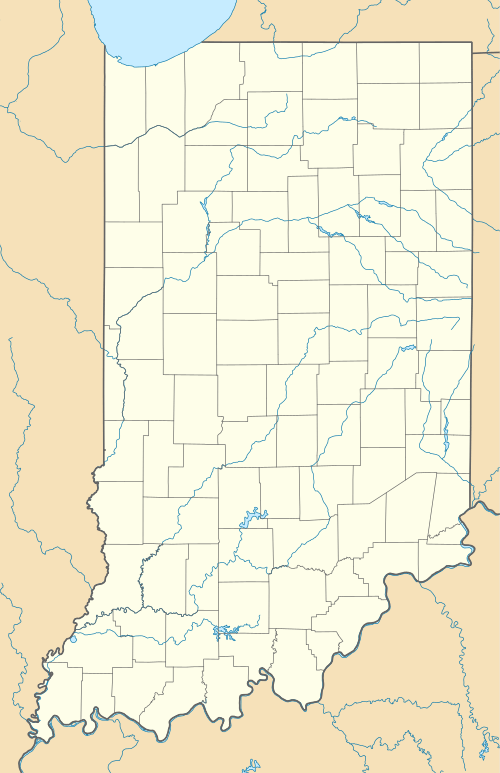Rockhouse Cliffs Rockshelters
|
Rockhouse Cliffs Rock Shelters (12PE98; 12PE100) | |
|
Comprehensive view of the shelters; 12PE100 to the left and 12PE98 to the right | |
  | |
| Location | By the spring in Rockhouse Hollow, northwest of Derby, Indiana[1]:31 |
|---|---|
| Coordinates | 38°3′35″N 86°34′40″W / 38.05972°N 86.57778°WCoordinates: 38°3′35″N 86°34′40″W / 38.05972°N 86.57778°W |
| Area | 1 acre (0.40 ha) |
| NRHP Reference # | 86000918[2] |
| Added to NRHP | April 25, 1986 |
The Rockhouse Cliffs Rockshelters (12PE98 and 12PE100) are a pair of rockshelters in the far southern region of the U.S. state of Indiana. Located amid broken terrain in the Hoosier National Forest, the shelters may have been inhabited for more than ten thousand years by peoples ranging from the Early Archaic period until the twentieth century. As a result of their extensive occupation and their remote location, they are important and well-preserved archaeological sites and have been named a historic site.
Geology

The shelters are located in western Union Township just south of the Leopold Township line in central Perry County;[1]:27 their PLSS location is Section 24, Township 5 South, Range 2 West.[1]:31 This portion of the county is extremely difficult of access: Perry County is the hilliest part of Indiana,[3] and the land surrounding the shelters is isolated even by Perry County standards.[1]:31 The area was once heavily cultivated, but during the 1930s, the Civilian Conservation Corps engaged in a reforestation program on the former farmsteads.[1]:38 Rockshelters are common in the region; a cursory field survey found 70 shelters countywide in 1953.[1]:37
Between the two shelters, 50 feet (15 m) away from the southern shelter, lies a small spring. A road formerly ran atop the cliff edge, but when the area became a forest preserve, the road was abandoned, and it was inaccessible to all wheeled vehicles by the 1950s.[1]:31
Archaeological investigations
Some of the earliest digging at the site appears to have occurred during the 1930s: the foreman of a reforestation team active in the area was an avid pothunter, and every new rockshelter that he encountered was subject to "exploration" by his crewmen.[1]:38 The Rockhouse Cliffs Rockshelters were recorded by the first scholarly archaeological survey of Perry County. Conducted by a team led by University of Georgia archaeologist James H. Kellar in mid-1953, the survey operated under the sponsorship of the Indiana Historical Bureau and the guidance of Indiana University archaeologist Glenn Black.[1]:5
Conclusions

Rockhouse Cliffs was occasionally inhabited during the Early Archaic period,[4] although neither Rockhouse Cliffs nor other shelters in the Hoosier National Forest has produced signs of house construction.[4] Among the distinctive forms of Archaic points found at the site is the Elk River Stemmed type; Rockhouse Cliffs is one of the most important sites known to have yielded this point, which has been found as far away as Russell Cave in northern Alabama as well as in prominent closer sites such as western Kentucky's Indian Knoll.[5]
Preservation

The shelters were listed on the National Register of Historic Places in April 1986 because of their archaeological importance; they are two of just three National Register-listed rockshelter sites in Indiana, along with the Potts Creek Rockshelter to the north in Crawford County.[2]
References
- 1 2 3 4 5 6 7 8 9 Kellar, James H. An Archaeological Survey of Perry County. Indianapolis: Indiana Historical Bureau, 1958.
- 1 2 National Park Service (2010-07-09). "National Register Information System". National Register of Historic Places. National Park Service.
- ↑ Welcome, Perry County, n.d. Accessed 2013-05-02.
- 1 2 Looking at Prehistory: Early Archaic Period 8,000 to 6,000 B.C., Forest Service, 2008-11-21. Accessed 2013-05-02.
- ↑ Justice, Noel D. Stone Age Spear and Arrow Points of the Midcontinental and Eastern United States : a Modern Survey and Reference. Bloomington: Indiana UP, 1995, 112.
External links
 Media related to Rockhouse Cliffs Rockshelters at Wikimedia Commons
Media related to Rockhouse Cliffs Rockshelters at Wikimedia Commons


